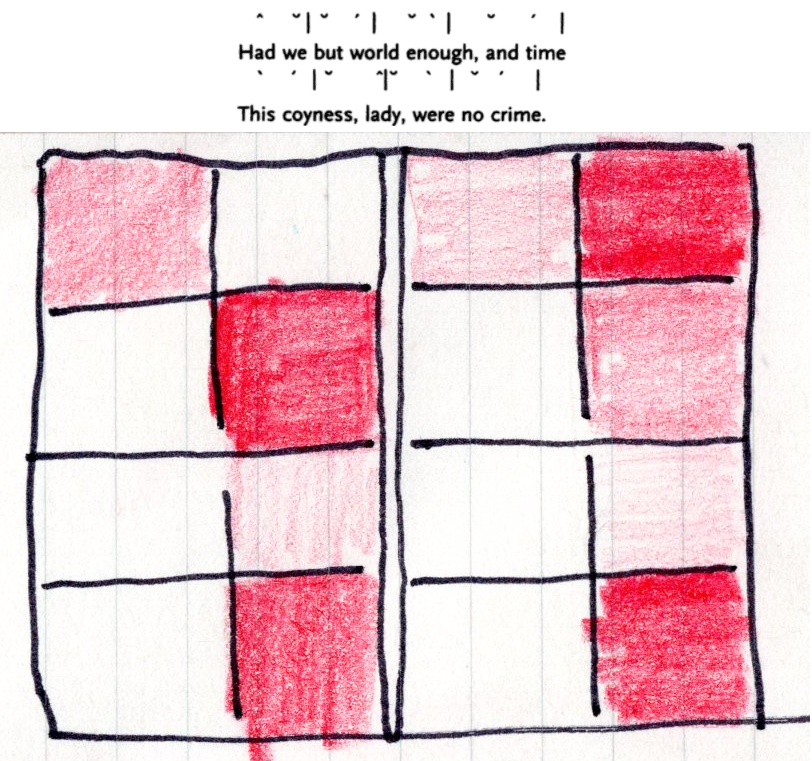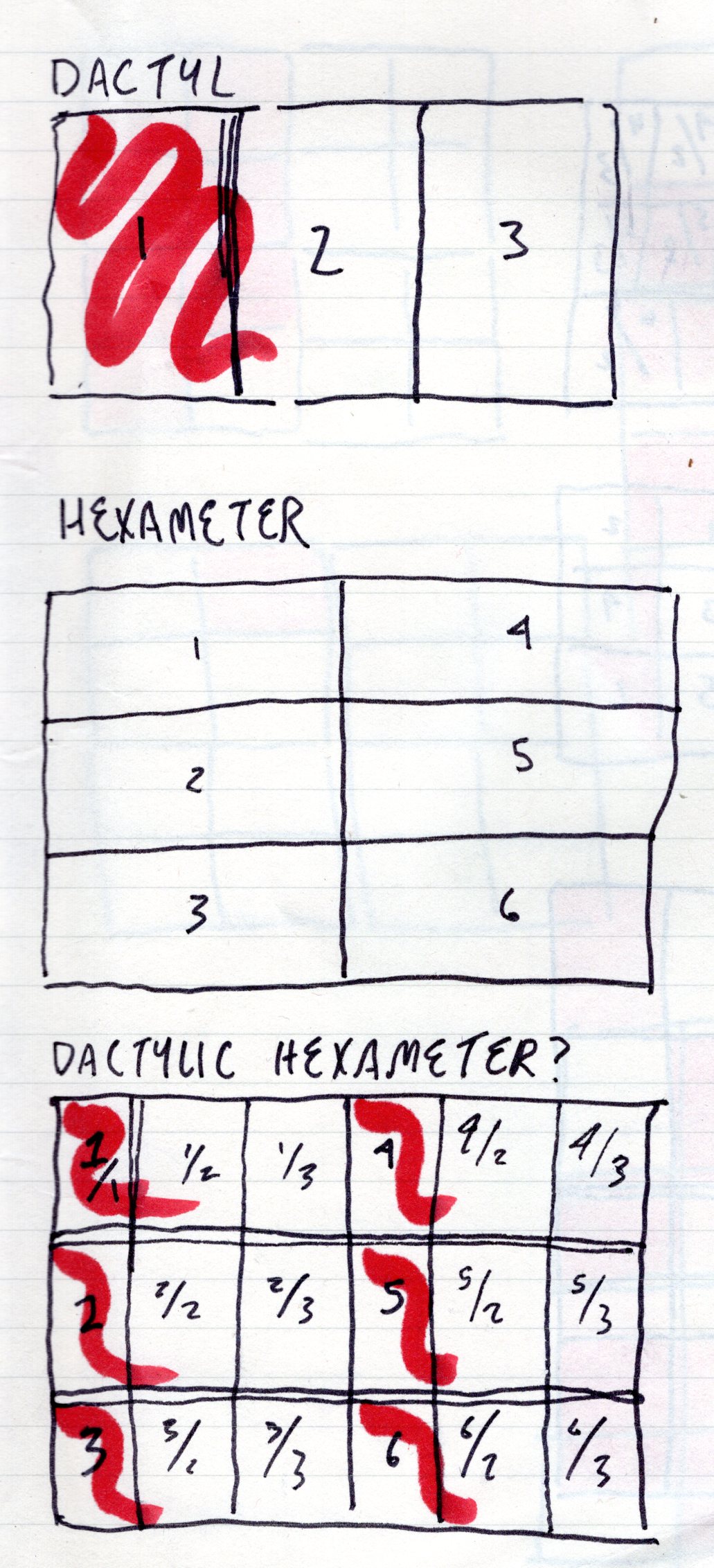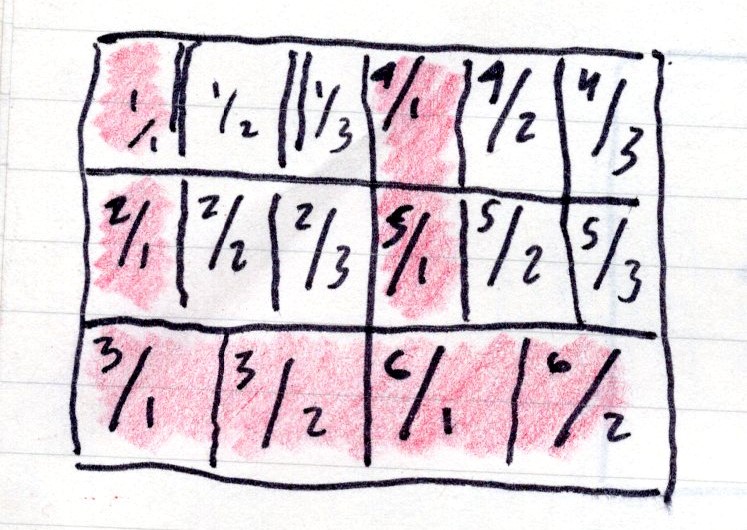by Jackie Kirby
Above, I have taken the opening couplet of Andrew Marvell’s “To His Coy Mistress” (1681) scanned and annotated by Phillip Hobsbaum in Metre, Rhythm, and Verse Form (1996) and translated it into an 8-panel grid spread using values of red as a accentual tool. Approaching comics with the assumption that they are or can be included within the scope of poetic practice, one is brought to draw a connection between the formal structures through which time and meaning are manifested on the page: in the comic, geometry and the grid; and in the poem, meter and verse form. Here, I will present what could generously be called “notes” towards a theory of meter and geometry. I apologize now for the inevitable imperfection of the metaphor, but I find this to be an important and positive aspect of the connection between the two, rather than a caveat negating any use the metaphor may provide.
Meter is the method of measuring verse by counting elements of it. It is a primarily mathematical system; it was called “numbers” by the Classical poets. Most often, the poet is counting syllables, as many languages exist primarily as a succession of syllables. Through different uses of meter, different methods of counting and measuring, different patterns of arrangement, writers create prosody, or a system of language. Within each language there exist many theories of organization, each of which is catered to both the language the writer uses and the purpose for which she wishes to use it. English poetry uses an accentual-syllabic metrical system, where the units being counted are syllables, and their pattern is defined by the arrangement of more or less strongly emphasized, or accented, syllables. Other languages use different systems. Languages which do not accentuate as strongly, such as French, will use something more akin to a purely syllabic meter, where forms are defined by the counting of syllables and ordering of numbers. This was also used by Ancient Irish and Welsh poets. Classical Greek and Latin poets based their prosody on the number of syllables and the length of time it takes to speak each syllable, creating patterns by arranging longer and shorter syllables. This is all to say, meter is a tool that must be developed accounting for the idiosyncrasies of the language in which one wishes to write. By looking at the metrical forms used by poets across different languages, and restructuring them for use in the language of comics, one can produce comic forms with increased complexity without decreasing (and perhaps even increasing) their legibility.
In an initial attempt at translating verse form to comic form let us equate syllables with panels, and spreads with lines. Each row of panels will represent a metrical foot. Stress is produced relationally, and in comics one can use size, color, density, and a myriad of other visual techniques to “stress” a panel. The actual size of each panel per “foot” or row is up to your own discretion but I prefer to use a more qualitative than quantitative approach to my “comics scansion.”
The first verse form I’d like to look at is dactylic hexameter, or Homer’s verse. It is the verse used in the Iliad and Odyssey, and later in Latin by Ovid and Virgil. Its historical use has equated it with the most grandiose poetic narratives, and cues a reader that she is reading a grand epic. Dactylic refers to the primary foot pattern of the poem, a dactyl being a long or stressed syllable followed by 2 short or unstressed syllables, while hexameter refers to the number of feet per line, which is 6 in this case (as opposed to pentameter [5], tetrameter [4], etc.). Using the system of translation previously established, a “dactylic hexameter” comic, would consist of spreads with 6 rows of 3 panels each, with the primary pattern being to stress the first panel of each row. Visually, this can easily lead us to a spread of 2 pages using a 9-panel grid.
Another notable element of Homer’s verse is that the third and sixth feet may be spondees rather than dactyls. A spondee is a foot composed of 2 equally weighted syllables. This could provide a spread looking something like this.
Alternatively, one could equate the panel to a metrical foot, and the page to a line. This would produce 6-panel grids, with each spread serving as a couplet.
These are only a few different, relatively conservative, attempts at translating a single poetic verse form into comics. These are not prescriptions as to what certain meters must look like in comics, but demonstrations of the ways meter and verse form can be used to develop a prosody of comics. There is such a plethora of verse forms, all with their own particular uses that can be translated into comics. As shown in the Marvell scansion above, the 8-panel grid is quite suited for translating iambic tetrameter, which is used most commonly in the ballad form. This connection could lead to all sorts of comics practices or translated ballads.
The harmony of a metered line is based on the same mathematical principals that produce visual harmony in geometric patterns. For instance, the sonnet, one of the most commonly used poetic forms, consisted originally of an octave (8-line stanza) followed by a sestet (6-line stanza). Poetry scholars have connected this with the golden ratio (8/5) with an extra line added to complete an even-numbered rhyme scheme. I have annoyed (to say the least) a number of English department chairs by insisting that poetry is simply linguistic mathematics. Certainly it’s (a bit) more than that, but much of poetics is applied mathematics, just as comics are.
—————————————————————————————————————
Jackie Kirby is a poet and comics maker living in New York City. A recent graduate from The New School with a BA in Cultural Studies, she has been making comics and writing poetry seriously for three years. Check out work by Jackie on her website, and follow her on Instagram. Read Jackie’s Comics Workbook Rowhouse Residency Report for more thoughts on comics and poetry.



